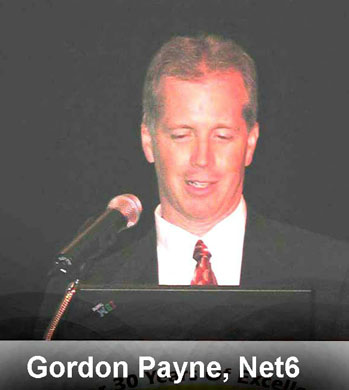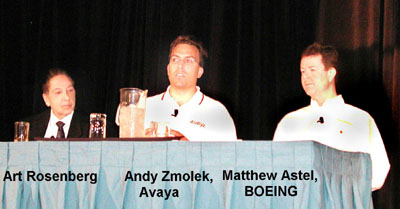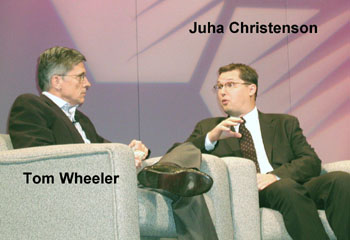| On The Conference
Trail
We get invited to speak at a number of
different technology shows and conferences because of our objective views
of user needs for converged communications. Although show and conference
attendance has dropped significantly in the past few years because of the
economy, 9/11 travel fears and the increased use of Web teleconferencing,
these venues provide valuable insights on industry and market progress
towards converged communication technologies.
We have attended or participated in several
of these events recently and want to report on some of the important
highlights from our unique perspective. (This may be particularly useful
for those of you who don’t travel as much as you used to.)
Internet Telephony Conference and Expo
– October 14-16, 2003
Technology Marke ting Corporation’s Internet Telephony Conference &
Expo, held in Long Beach, CA, gave some evidence of a market
turnaround with increased attendance and exhibitors, according to Rich
Tehrani, president and conference chairman of TMC. The big emphasis, of
course, was on migration to IP infrastructure for Voice over IP and IP
Telephony, and the impact of new security challenges on IP-based voice
communications. The strategic role of Session Initiation Protocol (SIP)
was highlighted at many of the program sessions. ting Corporation’s Internet Telephony Conference &
Expo, held in Long Beach, CA, gave some evidence of a market
turnaround with increased attendance and exhibitors, according to Rich
Tehrani, president and conference chairman of TMC. The big emphasis, of
course, was on migration to IP infrastructure for Voice over IP and IP
Telephony, and the impact of new security challenges on IP-based voice
communications. The strategic role of Session Initiation Protocol (SIP)
was highlighted at many of the program sessions.
Although we had only a limited time at the
conference, we were impressed with the keynote presentation by Gordon
Payne, chief marketing officer for Net6.
Net6 provides network-based “transformation gateways” to support
enterprise application information delivery to a variety of screen-based
IP telephones and wireless devices. Their transcoding approach enables
existing applications to easily and flexibly exploit the diverse
communication requirements of end users' information delivery, regardless
of location.
We will be curious to see how their kind of
technology will blend into the higher “layers” of IP-based (SIP)
real-time presence/availability/modality management that will be
particularly critical to mobile enterprise users. We recently sat in on a
Webinar conducted by IMlogic,
which provides enterprise server software for managing and controlling all
aspects of instant messaging (IM) activity for enterprise users, including
using external public IM network services. They have particularly targeted
vertical markets, such as financial services and health care, where
person-to-person communications are both time-critical and
security-sensitive.
International
Association of Messaging Professionals (IAMP) – October 20-23, 2003
We were a keynote speaker at the annual conference of this association
of Octel voice mail users, which was focused on migrating gracefully
toward converged enterprise communications through new product upgrade
strategies of their technology provider, Avaya, Inc. Our
presentation highlighted the results of our survey of the IAMP membership
to track the status of the enterprise movement toward converged
communications, as well as a special session introducing the new security
issues that IP-based networking brings to both traditional voice
communications and mobile, multi-modal communications.

Avaya is making a concerted effort to
enable their large installed customer base to move comfortably from their
legacy voice technologies into a converged IP infrastructure at their own
pace. They have even gone so far as to preserve the familiar Octel voice
mail user interfaces to minimize the impact on end users. However, the
feedback survey from attendees confirmed the findings of our own IAMP
survey, i.e., that enterprise telecommunication managers are still
confused about their role and new responsibilities in planning and
supporting users in a converged communications environment.
The complexities of communications
convergence and enterprise security, which is a relatively new problem for
traditional wired telephony, was highlighted by presentations from both
Avaya and Matthew Astel, responsible for unified and mobile messaging at
The Boeing Company. He observed that real problems about organizational
responsibilities are also surfacing because of multiple technologies
converging at the end-user’s interface with communication devices. Until
now, communications convergence, like unified messaging and VoIP, has been
usually pushed by the voice folks, rather than the data side.
Unified messaging and mobile messaging
systems involve multiple groups across an organization. These groups
include voice mail, e-mail, telecommunications, data network, directory,
security and handheld devices. There are challenges with deployment,
but the main challenges involve supporting the system. Many organizations
are struggling with these challenges. Should vendors assist
organizations in meeting these support challenges?
An example of the user support challenge is
when you have a wireless handheld device like a BlackBerry, Pocket PC, “smart-phone”
or Palm. You access your company voice mail and e-mail with the
device. You use a virtual private network (VPN) client to view internal
Web information and access database applications. You make and receive
phone calls using the device, maybe over a Wi-Fi connection. When any of
these functions don’t work, whom do you go to for help? Is it an
issue involving the wireless (cellular or Wi-Fi), the VPN client or
system, the handheld operating system, the handheld applications, the
enterprise e-mail service, or the Web server's rendering for a small
screen device?”
CTIA, October 20-23, 2003
Although the Cellular Telephony & Internet Association show in Las
Vegas was primarily focused on service provider offerings for consumers,
services for the enterprise were also the subject of some of the keynote
presentations.
CTIA retiring President and CEO, Tom
Wheeler trumpeted, “Wireless data has arrived,” in connection with
CTIA statistics about the 70 percent increase in revenue in the
first half of 2003 over the same period in 2002, and a 300 percent
increase over 2001. Much of this traffic, however, was in the form of
Short Messaging Services (SMS) used for audience voting on reality TV
shows, rather than information retrieval or Web browsing. Using the
just-announced Common Short Code Registry Service for common, easy
addressing of messaging responses across all major wireless operators, SMS
provides a convenient alternative to dialing in from wired phones for such
real-time polling. SMS and MMS of course are valid forms of one-way,
person-to-person text messaging for cell phones that are popular in
Europe, but may give way in the future to two-way, wireless instant
messaging. about the 70 percent increase in revenue in the
first half of 2003 over the same period in 2002, and a 300 percent
increase over 2001. Much of this traffic, however, was in the form of
Short Messaging Services (SMS) used for audience voting on reality TV
shows, rather than information retrieval or Web browsing. Using the
just-announced Common Short Code Registry Service for common, easy
addressing of messaging responses across all major wireless operators, SMS
provides a convenient alternative to dialing in from wired phones for such
real-time polling. SMS and MMS of course are valid forms of one-way,
person-to-person text messaging for cell phones that are popular in
Europe, but may give way in the future to two-way, wireless instant
messaging.
Keynoters from Microsoft and Intel aimed at
enterprise users who will use wireless devices as an alternative to wired
desktop PCs for information access. In particular, the rise of Wi-Fi
connectivity will increase notebook mobility. However, we seriously
question the practical use of handheld devices with small screens and tiny
keyboards to do much more than person-to-person communications and short
informational alerts. Obviously, with Bluetooth or USB accessories, the
handheld device can become the wireless “brains” for full desktop
screen and keyboard work.
One keynoter, Juha Christensen (since
departed from Microsoft), reported that two-thirds of “consumer”
wireless messaging activities are carried out by people who have business
jobs, but also pockets of “downtime” which they use for personal
matters, not just business. He made the argument for enabling enterprise
users to carry a single wireless device for both business and personal
communications.
Part 2
Copyright © 2003 The
Unified-View, All Rights Reserved Worldwide
|